Discover Florida Nature
It's time to explore the natural Florida


|
|
|
|
|
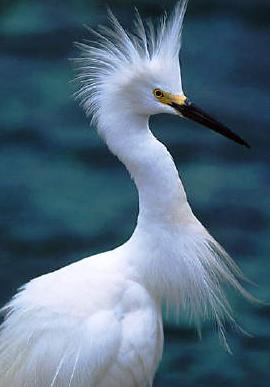 Snowy
Egret
(Egretta thula) SSC- The snowy egret is a medium sized. all
white, heron. This bird has an average weight of 13-14 ounces and is
typically about 24 inches long. A small, active bird, the Snowy Egret is
found in small ponds as well as along the ocean shore. Its black legs
and yellow feet and snowy white body quickly identify it. The snowy
egret has a long, thin neck, bill and legs. Found along much of the
East Coast in the U.S., snowy
egrets spend the winter from South Carolina southward. Their main foods
are fish, crabs, amphibians, and insects. Their flat, shallow nests are
made of sticks and lined with fine twigs and rushes. Three to four
greenish-blue, oval eggs are incubated by both adults. The young leave
the nest in 20 to 25 days and hop about on branches near the nest before
finally departing. Snowy
Egret
(Egretta thula) SSC- The snowy egret is a medium sized. all
white, heron. This bird has an average weight of 13-14 ounces and is
typically about 24 inches long. A small, active bird, the Snowy Egret is
found in small ponds as well as along the ocean shore. Its black legs
and yellow feet and snowy white body quickly identify it. The snowy
egret has a long, thin neck, bill and legs. Found along much of the
East Coast in the U.S., snowy
egrets spend the winter from South Carolina southward. Their main foods
are fish, crabs, amphibians, and insects. Their flat, shallow nests are
made of sticks and lined with fine twigs and rushes. Three to four
greenish-blue, oval eggs are incubated by both adults. The young leave
the nest in 20 to 25 days and hop about on branches near the nest before
finally departing.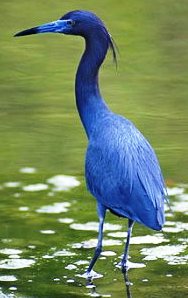 Little
Blue Heron
(Egretta caerulea) SSC- The Little Blue Heron is found along
the Atlantic coast, but is most
abundant along the Gulf of Mexico. The little blue heron often lives
near saltwater, but is mainly an inland bird. They prefer freshwater
areas such as ponds, lakes, marshes, swamps, and lagoons. The Little
Blue Heron is a small, dark bird that ranges from 23-27 inches in
length. It can have a wingspread of up to 40 inches. The sexes look
similar, but the young look very different from the adults. An adult
little blue heron can be recognized by its purple-maroon head and neck.
The rest of the plumage is slate gray. The long neck is usually held in
an "S" shaped curve while the bird is at rest or in flight. The heron's
long, slender bill curves slightly downward, and is also dark gray but
has a black tip. The eyes are yellow and the legs and feet are dark. The
young are unlike any other heron because they have all white body
plumage. They have a blue bill with a black tip and dull green legs.
They stay white through their first summer, fall, and into winter. Little
Blue Heron
(Egretta caerulea) SSC- The Little Blue Heron is found along
the Atlantic coast, but is most
abundant along the Gulf of Mexico. The little blue heron often lives
near saltwater, but is mainly an inland bird. They prefer freshwater
areas such as ponds, lakes, marshes, swamps, and lagoons. The Little
Blue Heron is a small, dark bird that ranges from 23-27 inches in
length. It can have a wingspread of up to 40 inches. The sexes look
similar, but the young look very different from the adults. An adult
little blue heron can be recognized by its purple-maroon head and neck.
The rest of the plumage is slate gray. The long neck is usually held in
an "S" shaped curve while the bird is at rest or in flight. The heron's
long, slender bill curves slightly downward, and is also dark gray but
has a black tip. The eyes are yellow and the legs and feet are dark. The
young are unlike any other heron because they have all white body
plumage. They have a blue bill with a black tip and dull green legs.
They stay white through their first summer, fall, and into winter.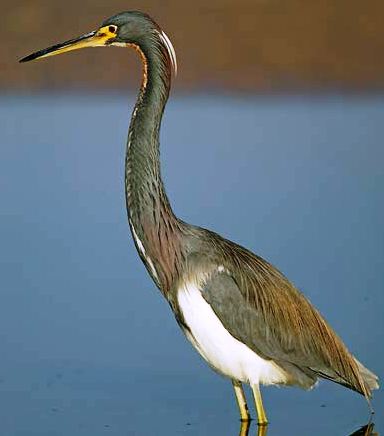 Tricolored
Heron (Egretta tricolor) SSC- The tricolored heron is about 22
inches in length and has a wingspan of about three feet. It has slate
blue feathers on most of its body except for a white chest and belly and
a rust-colored neck. It has long yellow legs, a white stripe that runs
up its neck and long pointed yellow bill. The bill turns blue during
breeding season. Males and females look alike. The tricolored heron
wades in the water in search of prey. It mostly eats fish but it also
will eat amphibians, insects and crustaceans. The tricolored heron
breeds in southeastern New Mexico and Texas, on the Gulf Coast and on
the Atlantic Coast from Florida to
southern Maine. The tricolored heron can be found in marshes, swamps,
bayous, mudflats, lagoons and coastal ponds. Tricolored
Heron (Egretta tricolor) SSC- The tricolored heron is about 22
inches in length and has a wingspan of about three feet. It has slate
blue feathers on most of its body except for a white chest and belly and
a rust-colored neck. It has long yellow legs, a white stripe that runs
up its neck and long pointed yellow bill. The bill turns blue during
breeding season. Males and females look alike. The tricolored heron
wades in the water in search of prey. It mostly eats fish but it also
will eat amphibians, insects and crustaceans. The tricolored heron
breeds in southeastern New Mexico and Texas, on the Gulf Coast and on
the Atlantic Coast from Florida to
southern Maine. The tricolored heron can be found in marshes, swamps,
bayous, mudflats, lagoons and coastal ponds. 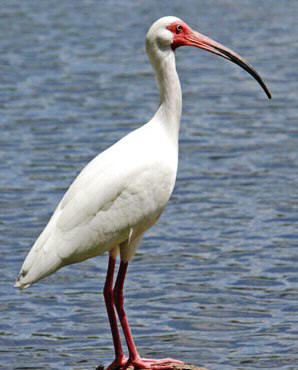 White
Ibis
(Eudocimus albus) SSC- A wading bird of the deep South, the striking
White Ibis is frequently seen on lawns looking for large insects as well
as probing for prey along the shoreline. The white ibis builds a stick
nest in trees, bushes, or over water, and 2 to 5 eggs are typically
laid. The ibis feeds by probing with its long, down curved beak. Its
diet consists of various fish, frogs and other water creatures, as well
as insects and small reptiles. Adults are 65 cm long with a 95 cm
wingspan. White ibis have all-white plumage except for black wingtips
(visible in flight) and reddish bills and legs. The red bill blends into
the face of breeding birds; non-breeding birds show a pink to red face.
Like the other species of ibis, the White Ibis flies with neck and legs
outstretched, often in long, loose lines. White
Ibis
(Eudocimus albus) SSC- A wading bird of the deep South, the striking
White Ibis is frequently seen on lawns looking for large insects as well
as probing for prey along the shoreline. The white ibis builds a stick
nest in trees, bushes, or over water, and 2 to 5 eggs are typically
laid. The ibis feeds by probing with its long, down curved beak. Its
diet consists of various fish, frogs and other water creatures, as well
as insects and small reptiles. Adults are 65 cm long with a 95 cm
wingspan. White ibis have all-white plumage except for black wingtips
(visible in flight) and reddish bills and legs. The red bill blends into
the face of breeding birds; non-breeding birds show a pink to red face.
Like the other species of ibis, the White Ibis flies with neck and legs
outstretched, often in long, loose lines.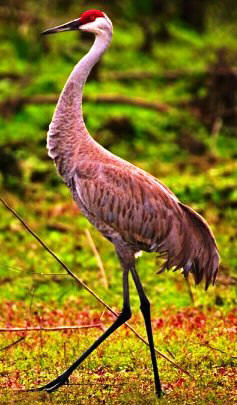 Florida
Sandhill Crane
(Grus canadensis pratensis) Threatened- Florida sandhill cranes are
long-legged, long-necked, gray, heron-like birds with a patch of bald,
red skin on top of their heads. Sandhill cranes fly with their necks
outstretched with powerful, rhythmic wing beats. Florida's sandhill
cranes are a threatened species that are found in inland shallow
freshwater marshes, prairies, pastures and farmlands. Sometimes they can
be seen on lawns throughout Florida. They are sensitive birds that do
not adjust well to changed environments and high human populations.
Sandhill cranes are usually seen in small family groups or pairs,
however, during the winter, Florida's sandhill crane population
increases as cranes from northern states spend the winter in Florida.
Sandhill cranes are omnivorous and some of their favorite meal items
include seeds, plant tubers, grains, berries, insects, earthworms, mice,
snakes, lizards, frogs and crayfish. Unlike other wading birds, such as
herons, sandhill cranes do not "fish." The voice of the sandhill crane
is one of the most distinctive bird sounds in Florida. This "call of the
wild" has been described as a bugling or trumpeting sound, and can be
heard for several miles. Florida
Sandhill Crane
(Grus canadensis pratensis) Threatened- Florida sandhill cranes are
long-legged, long-necked, gray, heron-like birds with a patch of bald,
red skin on top of their heads. Sandhill cranes fly with their necks
outstretched with powerful, rhythmic wing beats. Florida's sandhill
cranes are a threatened species that are found in inland shallow
freshwater marshes, prairies, pastures and farmlands. Sometimes they can
be seen on lawns throughout Florida. They are sensitive birds that do
not adjust well to changed environments and high human populations.
Sandhill cranes are usually seen in small family groups or pairs,
however, during the winter, Florida's sandhill crane population
increases as cranes from northern states spend the winter in Florida.
Sandhill cranes are omnivorous and some of their favorite meal items
include seeds, plant tubers, grains, berries, insects, earthworms, mice,
snakes, lizards, frogs and crayfish. Unlike other wading birds, such as
herons, sandhill cranes do not "fish." The voice of the sandhill crane
is one of the most distinctive bird sounds in Florida. This "call of the
wild" has been described as a bugling or trumpeting sound, and can be
heard for several miles.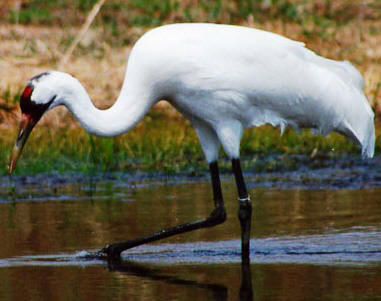 Whooping
Crane (Grus americana) SSC- The Whooping Crane the tallest
North American bird, is an endangered crane species named for its
whooping sound and call. Along with the Sandhill Crane, it is one of
only two crane species found in North America. The whooping crane's
lifespan is estimated to be 22 to 24 years in the wild. Adult whooping
cranes are white with a red crown and a long, dark, pointed bill.
Immature whooping cranes are pale brown. While in flight, their long
necks are kept straight and their long dark legs trail behind. Adult
whooping cranes' black wing tips are visible during flight. This bird
stands nearly 5 feet tall with a wingspan of 7.5 feet. Males weigh on
average 17 lb, while females weigh about 14 lb. Whooping cranes forage
while walking in shallow water or in fields, sometimes probing with
their bills. They are omnivorous and slightly more inclined to animal
material than most other cranes. Whooping
Crane (Grus americana) SSC- The Whooping Crane the tallest
North American bird, is an endangered crane species named for its
whooping sound and call. Along with the Sandhill Crane, it is one of
only two crane species found in North America. The whooping crane's
lifespan is estimated to be 22 to 24 years in the wild. Adult whooping
cranes are white with a red crown and a long, dark, pointed bill.
Immature whooping cranes are pale brown. While in flight, their long
necks are kept straight and their long dark legs trail behind. Adult
whooping cranes' black wing tips are visible during flight. This bird
stands nearly 5 feet tall with a wingspan of 7.5 feet. Males weigh on
average 17 lb, while females weigh about 14 lb. Whooping cranes forage
while walking in shallow water or in fields, sometimes probing with
their bills. They are omnivorous and slightly more inclined to animal
material than most other cranes.
|
|
|
Advertise | Privacy Statement | Dog Encyclopedia | Video |Contact | Alaska Nature |
|